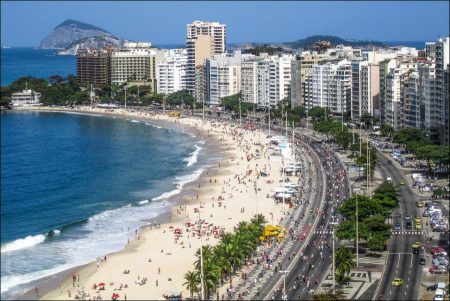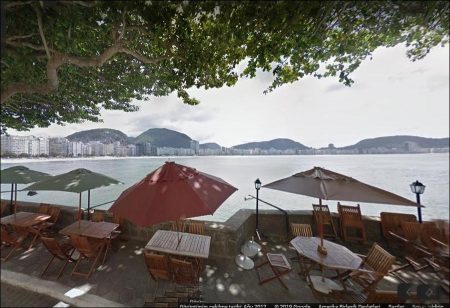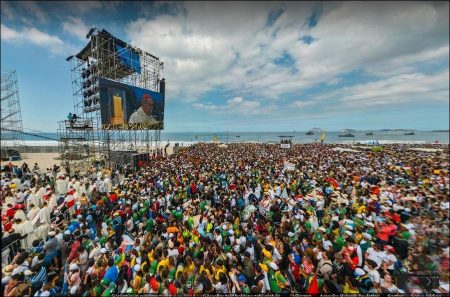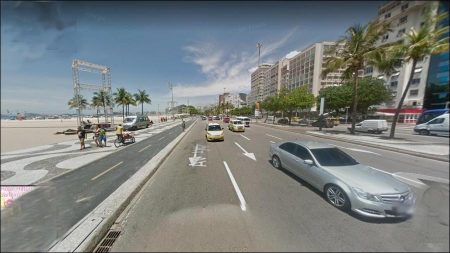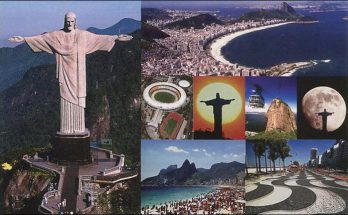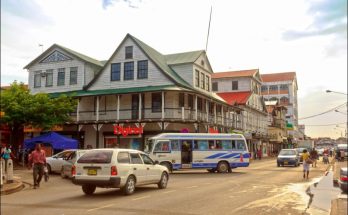A four-kilometer stretch of yellow-gold sand, Copacabana beach is one of Rio de Janeiro’s most iconic and visited attractions. Once a small crescent of sand, it was transformed into the thriving, tourist hotspot it’s known as today. We take a stroll through time to discover how Copacabana beach became one of the world’s most famous coastlines.
Edged by busy kiosks and towering palm trees, Copacabana beach is a frenzy of activity: sunbathers routinely switch sides to get the perfect tan; beach vendors brave Rio’s relentless sun to sell drinks, food and souvenirs; sports enthusiasts play games of football, surf, run, or slam a volleyball over the net. On a summer’s weekend, the place gets packed and beach-goers will find themselves jostling for a spot on the sand, yet the crowds bring life and energy to the shoreline and the background samba beats puts a spring in everyone’s step.
The long shoreline begins at the Copacabana Fortress, an important site for Rio’s military that is also a popular tourist attraction with a museum about Brazil’s army, endless views over the beach and ocean, and a luxurious coffee shop serving a mouthwatering selection of confectionery and lunch options. It then stretches to Posto 2 (lifeguard point 2) before it seamlessly blends into Leme Beach. Following the beach is the famous black and white promenade patterned with a wavy motif that was inspired by Portuguese pavements from the 1930s. It was Roberto Burl Marx, a Brazilian landscape architect, that brought the idea to Brazil and replicated the Portuguese design in Copacabana in 1970.
Before 1970, the Copacabana shoreline looked a lot different – the road that follows the beach, known as Avenida Atlantica, was narrow and the sea often reached the avenue, leaving little space for a sandy retreat. In 1970, Hildebrando de Goes Filho, a hydraulic engineer and president of CBD-cia, led a team to completely change the structure of Copacabana’s coastline by creating a large landfill. There were two reasons for this – the first was to widen Avenida Atlantica avenue and build a more advanced sewage system, and the second was to extend the width of the beach to prevent the sea reaching the main roads and flooding properties there.
The transformation was a success and quick-thinking businesses started to spring up, providing restaurants, hotels and beach kiosks for the growing number of tourists to the region. Despite the increasing competition on Copacabana’s beachside, the Copacabana Palace has established itself as the most symbolic hotel in the region and remains one of Rio’s significant monuments.
Paved throughout with carrara marble and adorned with classic paintings and ornate chandeliers, Copacabana Palace creates an air of elegance and sophistication and has hosted a wealth of famous guests such as The Rolling Stones, Marilyn Monroe and Michael Jackson. A feature in the movie Flying Down to Rio starring Ginger Rogers and Fred Astaire elevated Copacabana Palace’s stardom and turned it into an iconic attraction.
Besides the hundreds of thousands of people that flock to Copacabana beach each year for Carnival celebrations and Gay Pride, New Year’s Eve is by far the largest event of them all that takes place on its sandy shores. Around two million people attend the event in Copacabana for New Year which includes live shows with some of the best international music acts and one of the most impressive firework displays in the world. In addition to party-goers, the beach becomes a religious ritual site as worshipers of Candomblé and Umbanda leave offerings to their gods in the sea and make silent prayers as the fireworks and whoops of the crowd ring in the background.
These huge events attract hordes of people, and Copacabana beach continues to reel in visitors throughout the year thanks to its iconic status and pleasant all-year-round climate. The beach is also well-lit at night, allowing for night-time strolls along the shore and games of sports on the sand.
Visits: 503
